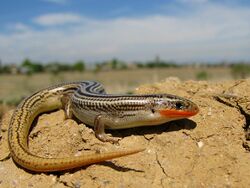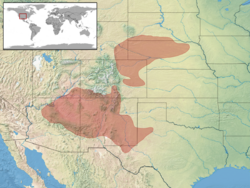Biology:Plestiodon multivirgatus
| Plestiodon multivirgatus | |
|---|---|

| |
| Scientific classification | |
| Domain: | Eukaryota |
| Kingdom: | Animalia |
| Phylum: | Chordata |
| Class: | Reptilia |
| Order: | Squamata |
| Family: | Scincidae |
| Genus: | Plestiodon |
| Species: | P. multivirgatus
|
| Binomial name | |
| Plestiodon multivirgatus Hallowell, 1857
| |

| |
| Synonyms[1] | |
| |
Plestiodon multivirgatus, commonly known as the many-lined skink, the northern many-lined skink, or the variable skink, is a medium-sized species of lizard, a member of the North American skink genus Plestiodon in the family Scincidae. The species is native to the western United States .
Taxonomy
The taxonomy of this species is somewhat unclear, even amongst researchers. Most commonly, two subspecies are recognized:
- P. m. multivirgatus (Hallowell, 1857) – northern many-lined skink
- P. m. epipleurotus (Cope, 1880) – variable skink
The latter is sometimes treated as a separate species Plestiodon epipleurotus or Plestiodon gaigeae (Taylor, 1935), or given as the subspecies P. m. gaigeae. These last two scientific names are in honor of American herpetologist Helen Beulah Thompson Gaige (1890–1976) of the University of Michigan.[2]
P. m. epipleurotus is also called the two-lined skink.
Description
The many-lined skink is a medium-sized skink reaching a maximum snout-to-vent length (SVL) of about 7.5 cm (3.0 in) and a total length of roughly 19 cm (7.5 in). Its body is olive to brown in color. P. m. multivirgatus has black stripes along the body and tail, while P. m. epipleurotus has two white stripes with black borders.[1]
Geographic range & habitat
The geographic range of P. m. multivirgatus in the north includes southern South Dakota, Nebraska, and Wyoming, and extends in the south to the Arkansas River in Colorado. P. m. multivirgatus prefers sandy soil and occurs in habitat below 1,675 m (5,495 ft).[3]
P. m. epipleurotus occurs from south-eastern Utah and southern Colorado through Arizona, New Mexico, and western Texas . It lives in rocky habitat up to elevations of 2,600 m (8,500 ft).[3]
Reproduction
P. multivirgatus is oviparous.[1] Eggs are deposited under rocks.[3]
References
- ↑ 1.0 1.1 1.2 Species Plestiodon multivirgatus at The Reptile Database www.reptile-database.org.
- ↑ Beolens, Bo; Watkins, Michael; Grayson, Michael (2011). The Eponym Dictionary of Reptiles. Baltimore: Johns Hopkins University Press. xiii + 296 pp. ISBN:978-1-4214-0135-5. (Eumeces multivirgatus gaigeae, p. 97).
- ↑ 3.0 3.1 3.2 Cite error: Invalid
<ref>tag; no text was provided for refs namediucn status 19 November 2021
Further reading
- Behler JL, King FW (1979). The Audubon Society Field Guide to North American Reptiles and Amphibians. New York: Alfred A. Knopf, Inc. 743 pp. ISBN:0-394-50824-6. (Eumeces multivirgatus, p. 574 + Plate 422).
- Conant R (1975). A Field Guide to Reptiles and Amphibians of Eastern and Central North America, Second Edition. Boston: Houghton Mifflin Company. xviii + 429 pp. + Plates 1-48. ISBN:0-395-19979-4 (hardcover), ISBN:0-395-19977-8 (paperback). (Eumeces multivirgatus, pp. 128–129 + Plate 19 + Map 78).
- Hallowell E (1857). "Description of several new North American Reptiles". Proc. Acad. Nat. Sci. Philadelphia 9: 215-216. ("Plestiodon multivirgatum [sic]", new species, p. 215).
- Powell R Conant R, Collins JT (2016). Peterson Field Guide to Reptiles and Amphibians of Eastern and Central North America, Fourth Edition. Boston and New York: Houghton Mifflin Harcourt. xiv + 494 pp., 47 plates, 207 figures. ISBN:978-0-544-12997-9. (Plestiodon multivirgatus, p. 310 + Plate 29).
- Smith HM, Brodie ED Jr (1982). Reptiles of North America: A Guide to Field Identification. New York: Golden Press. 240 pp. ISBN:0-307-13666-3. (Eumeces multivirgatus, pp. 78–79).
- Stebbins RC (2003). A Field Guide to Western Reptiles and Amphibians, Third Edition. The Peterson Field Guide Series ®. Boston and New York: Houghton Mifflin Company. xiii + 533 pp. ISBN:978-0-395-98272-3. (Eumeces multivirgatus, pp. 311–312 + Plate 36 + Map 111).
External links
- BISON fact sheet for P. m. epipleurotus
Wikidata ☰ Q2928191 entry
 |


